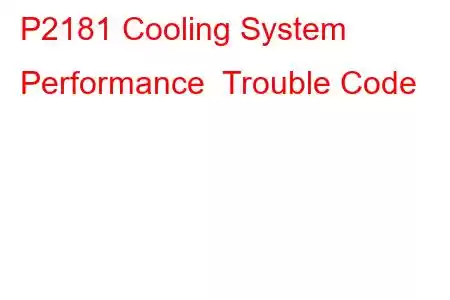P2181 Cooling System Performance Code
OBD-II Trouble Code Technical Description
Cooling System Performance
What does that mean?
This diagnostic trouble code (DTC) is a generic powertrain code. It is considered generic because it applies to all makes and models of vehicles (1996-newer), although specific repair steps may be slightly different depending on the model. The code may be seen on Dodge, Jeep, Chrysler, and other models.
Unlike most generic-computer fault codes that are relatively specific as to the items or area the fault occurred, code P2181 is vague to say the least. The fault is recognized and set if the engine temperature is out of range either too hot or cold.
Symptoms
The engine temperature gauge indicates a higher or lower than normal temperature. If the vehicle has no temperature gauge it will have a "red" temperature warning light, which means the engine is already overheating and must be shut down immediately. In the event the gauge is faulty or goes unnoticed, an overheating engine will cause the coolant to boil producing steam, the radiator/tank will overflow, and in the critical stages the engine will begin to knock, lose power and finally seize. If the engine is running cold, the fuel mixture will be rich, resulting in poor fuel economy, the heater will not function well and the temperature gauge will indicate colder than normal. All engines are designed to expand to a predetermined point as they heat up. It is critical to maintain the proper operating temperature for proper sealing of the piston rings.Effects on the Engine
Running too cool takes a backseat to overheating. The effects of running too cool happen over time and are correctable whereas overheating is always catastrophic if not corrected quickly. Just a few minutes of severe overheating and the engine will be destroyed.
Mild overheating usually results in a blown head gasket which is an expensive repair. Severe overheating will cause the pistons to expand faster than the cylinder block and seize in the cylinder bores for which there is no repair.
Procedures and Protocol
Due to the wide range of possibilities for overheating as the cause of code P2181, the following strategy will be employed. The flow of diagnostics will be used from an automotive technician's viewpoint. It will begin with the most often encountered to the least.
Warning: Never open a radiator cap unless the engine is either barely warm or cold. The cooling system is under pressure and the common temperature is 195 degrees, and an overheating engine can exceed 280 degrees. Bodily harm in the form of third degree burns will definitely occur.
Diagnostic Steps & Possible Solutions
Tools used in diagnosing overheating problems:
Temperature scan tool Voltmeter Set of alligator jaw jumper wires Scan tool to clear the codes Coolant system pressure tester Service manualEngine running too cool:
Replace the thermostat.Engine overheating:
Plug the code scanner into the OBD port and turn the key on. Check for any further codes. A coolant temperature sensor code will cause the radiator fans to malfunction. With the engine cold, remove the radiator cap and check the coolant level. With the pressure tester check for leaks in the system. This includes around the radiator, hoses, block, intake and heater core. If the engine temperature is normal while driving but overheats at a stop the radiator fan is malfunctioning. Check the serpentine belt-tension for proper tension. Defective belt tensioners are common and allow belt slip. Check around the water pump for leaks. For those driven by the timing belt, coolant leaks out of the bottom of the belt cover. If the water pump is exposed, check the pulley for wobble indicating a worn water pump bushing. Check an engine driven fan for wobbling and leakage around the fan clutch. RRead: 30


